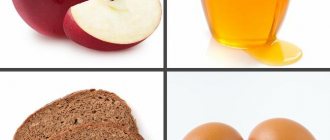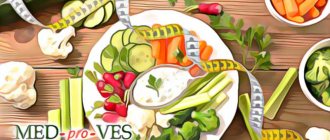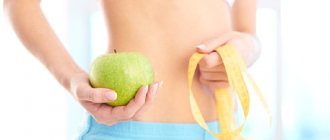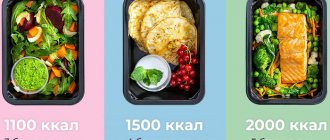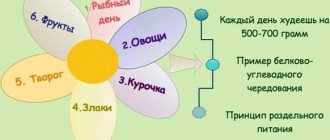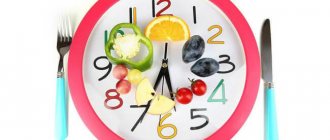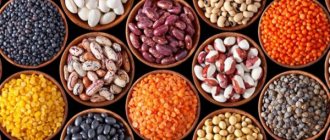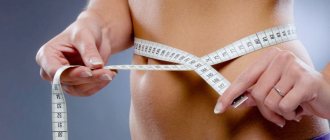Hello!
You may have started to have problems with your health and well-being. Or you're tired of being the biggest-boned among your friends. Maybe this morning the reflection in the mirror directly told you that you need to do something
. Every day, thousands of people, for these and other reasons, decide to switch to proper nutrition.
The decision is laudable, but to achieve success, you need to know at least the basics of proper nutrition. The Internet is full of resources that vying with myths (you can’t eat after 6) and unscientific methods that are dangerous to health (“kefir” and other diets). You won’t find anything like that in this article, it’s only supported by science (60 scientific sources) and my personal experience
effective principles of healthy eating.
Principle #1 Eat according to your body's needs
By eating right, we should receive from food only the energy we need for life (mental and physical activity) and basic metabolism.
Energy consumption is individual for everyone and depends on: - Gender (male, female); — Age; — Growth; — Metabolic speed; — General condition of the body; - Physical and mental activity.
If you exceed your calorie needs day after day, your weight will steadily increase.
If you eat sparingly and get little energy from food, this may cause a lack of vitamins and minerals.
How many calories do you need exactly?
In the previous article, we learned how to count the number of calories you need per day “How to start losing weight correctly at home - step-by-step instructions.”
You can read it in more detail later, but for now let’s quickly calculate the number of calories you need.
Let's assume that your weight, height and age are respectively: weight 70 kg, height 165 cm, age 32 years.
The Harris-Benedict formula will help you calculate the required number of calories: 655 + (9.563 x weight in kg) + (1.850 x height in centimeters) – (4.676 x age in years).
Substitute your values. 655 + (9.563 x 70) + (1.850 x 165) – (4.676 x 32) = 655 + 669.41 + 305.25 – 149.63 = 1480 kcal
The result was a general metabolism.
If you do not exercise at all and move little, multiply this value by 1.2. If you play sports at least 1-3 times a week, then by 1.3.
This way you will know your daily calorie requirement.
Principle No. 2 Maintain the proportions of proteins, fats and carbohydrates
It is important not only the number of calories eaten per day, but also the correct proportion of proteins, fats and carbohydrates.
In proper nutrition for weight loss, this proportion looks like this: 20-30% of energy comes from proteins; 20-25% are fats; 50-60% are carbohydrates.
Each nutrient plays its own irreplaceable role in the body, so nutrition must be composed competently and balanced.
A monotonous diet can cause a lack of nutrients and in the future cause various diseases.
For example, read what happens when there is a lack of magnesium in the body.
If a person does not receive the necessary nutrients, he begins to overeat, which causes overweight and obesity.
What is the difference between proper nutrition and diet?
Most people don't see any difference between PN and diets. Most often, this is what causes them disappointment. What are the main differences between PP and diet:
- The main goal of the weight loss technique is to get rid of excess weight. After all, the diet itself implies this. As a result, the diet is reduced and some foods and drinks are excluded. Depending on the type of diet, do the following. Some cut carbohydrates, others reduce caloric intake. There are more stringent weight loss systems - mono-diets. The main thing about them is weight loss. At the same time, the main goal of PN is to eat wholesome and healthy food, as well as improve the body’s vital signs.
- An important difference between PN and diet is dietary restriction. As a result, the immune system is weakened and the condition of hair, teeth and nails deteriorates. PP helps improve health and appearance. The functioning of the digestive organs improves, stomach pain, cramps and other negative symptoms decrease.
- The time frame is another difference between PP and diet. After all, the latter is observed for a certain time. And proper nutrition can be practiced throughout your life.
Therefore, it is important to choose the most useful method that will help maintain normal weight and excellent health.
Principle #3 Eat whatever you want, but in moderation
Proper nutrition is not a list of restrictions! You can eat sweets and fatty foods if you want. After all, sometimes you can afford sweets, pastries, cakes, but everything should be in small quantities.
Limit your salt and sugar intake. Almost every supermarket product contains salt and sugar. We get more than 80% of salt from semi-finished products. As a result, we consume almost 4 times more salt than normal.
Instead of sweets, eat raisins, dates, dried apricots, nuts, and seeds.
Try not to drink alcohol. The higher the degree, the more calories.
For example, two bottles of beer (1 liter) contain 500 calories.
What should be included in a diet for weight loss
The basic principles include the correct choice of products. To build the right menu, you can include the following products:
- Lean meats. These include: rabbit, beef, rabbit, chicken, turkey.
- Legumes.
- Dairy products. These include: cottage cheese, yogurt, kefir, sourdough and cheeses. It is important to avoid completely low-fat foods because they contain harmful trans fats.
- Cereals.
- Whole wheat bread.
- Pasta made from durum wheat.
- Fresh fruits, vegetables and herbs.
The diet for weight loss should not include: fast food, processed foods, sweet carbonated drinks, breakfast cereals, baked goods and other sweets.
Principle No. 4 Diversify your daily diet
Nowadays, almost every finished food product contains various E-additives. If you constantly eat the same foods, you can get too many preservatives and dyes of the same type, which is very harmful to health. (To find out which foods are the most harmful, read my article, food additives and danger table, which will be published next week).
Check your nutrition
Food should be varied.
Eat more fruits and vegetables. They contain various vitamins and minerals.
Eat more healthy unsaturated fats, which are found in vegetable oils, nuts, seeds, and avocados.
After all, if your diet is varied, you do not need to take vitamins and dietary supplements.
The only thing that is always advisable to take in addition to food for adults and children is Omega 3 vitamins.
You can check your nutrition and calculate calories for proper weight loss using the diary book “The Path to an Ideal Figure” in .pdf format
Buy a book from a nutritionist-nutritionist
“Food Diary: The Path to an Ideal Figure!” for 999 rubles 299 rubles.
Buy a book for 299 rubles:
*To buy the book, click the "Submit" button. The book will be sent to you by email, which you indicate when paying.
Principle No. 5 Stick to a proper diet
The main rule here is to eat every 2.5-3.5 hours.
The break between meals should not be more than four hours and less than two hours.
It is best to drink a glass of water 2 – 2.5 hours after eating, and start eating after 30 minutes.
If you really want to eat, snack on 5 nuts or 1 piece of fruit.
Have dinner no later than three hours before bedtime.
Principle #6 Drink more clean water
Drink 1 to 1.5 liters of clean water daily.
The daily need for water is approximately 30 ml per 1 kg of body weight. We receive from food in the process of metabolism, approximately from 0.8 to 1.3 liters. You can calculate your individual need for clean water and how much you need to drink per day.
Multiply your weight by 30.
Subtract 0.8 liters from this figure.
And subtract 1.3 l.
For example, a woman weighing 89 kg.
89 x 30 = 2.670 l. 2.670 – 0.8 = 1.870 2.670 – 1.3 = 1.370
The total is from 1.3 to 1.8 liters of clean water per day.
Principle No. 7 Reduce the amount of animal fats
Try to eat low-fat meat products (fish or poultry). If it's chicken, chicken breast is better than thighs.
The maximum serving size at a time is 120-160 grams.
Limit the consumption of semi-finished products: sausages, sausages, pates.
Due to the intake of large amounts of animal fats, the risks of increasing the level of bad cholesterol and the development of various diseases (oncology, heart disease, obesity, diabetes) increase.
What foods help you lose weight
There is such a thing as negative calorie foods. This means that the body spends more energy on digesting these foods than their calorie content. These products include:
- cabbage;
- salad;
- tomato;
- cucumber;
- citrus fruits - lemon, orange, lime, grapefruit;
- zucchini;
- squash;
- green onions;
- celery;
- berries - blueberries, strawberries, cranberries, raspberries, strawberries, gooseberries;
- melon;
- watermelon;
- a pineapple;
- pomegranate;
- mushrooms;
- green beans;
- carrot;
- garlic;
- onion.
The next group of products helps you lose weight by accelerating metabolic processes in the body.
- Green tea.
- Cinnamon.
- Ginger root.
- Ground pepper.
- Bitter chocolate.
- Coffee.
- Mustard.
Principle #8 Eat more complex carbohydrates
50% of the daily value comes from carbohydrates. They are the main source of our energy. Today, many people have significantly reduced their consumption of complex carbohydrates, replacing them with simple (refined) foods.
But it is complex carbohydrates that are useful - glycogen, starch, fiber, pectin.
Main suppliers of complex carbohydrates:
- Vegetables (potatoes, cabbage, beets, carrots, celery, pumpkin, olives, cucumbers, tomatoes, lettuce, spinach)
- Fruits (apples, pears, peaches, pomegranates, citrus fruits)
- Wholemeal bread
- Cereals (oatmeal, buckwheat, wheat, rice, millet, barley, pearl barley)
- Legumes (soybeans, beans, lentils, chickpeas)
- Durum pasta
Tips for organizing a PP diet
Proper nutrition for weight loss can be organized at home. Its main principle is regular, multiple meals in small portions. Products are selected based on daily calorie content, which is calculated individually using formulas or in an online calculator.
Online calculators will help you calculate your daily calorie intake and BJU balance. Next, according to the calorie tables, foods for each day are selected and divided into several meals at equal intervals. This is a rather difficult task, but you need to do all the calculations once, and you can also create your own menu, guided by your personal food preferences. If developing a menu seems like a complicated process, it’s worth looking for ready-made menus that take into account your daily caloric intake (menu for 1200 kcal, 1500 kcal, etc.).
Proper meals for weight loss look something like this:
| breakfast | 7-9 hours | Complex carbohydrates (cereals), protein dishes (omelettes, cottage cheese), fiber (fruits, juices). |
| lunch | 10-12 hours | Fermented milk products, grain breads, fruits |
| dinner | 13-15 hours | Complex carbohydrates, vegetable salads, side dishes, protein dishes from meat and fish |
| afternoon tea | 16-18 hours | Juices, fruits, desserts |
| dinner | 19-20 hours | Proteins (meat, fish, cottage cheese, eggs) and fiber (vegetables, herbs) |
| before bed if desired | 22-23 hours | Fermented milk products, sour fruits (apples, citrus fruits) |
As you can see from the table, breakfast is a mandatory meal. It should be light enough so as not to burden the barely “awakened” digestive system, but at the same time saturate the body with the energy necessary to start the working day.
Lunch can be quite hearty and filling, while dinner is preferable to be light so as not to burden the digestive system before bed. Snacking throughout the day serves to prevent the body from being stressed by long periods between meals. Due to such stress, excess calories begin to be stored in reserve, and we are at risk of overeating on something harmful.
Principle No. 9 Drink fermented milk products
The 9th principle of proper nutrition for weight loss is the daily consumption of fermented milk products with a fat content of 2.5% or 3.2% (kefir, bifidok, fermented baked milk, yogurt). They are very beneficial for liver and kidney health, help improve digestion and strengthen the immune system.
Avoid sweetened yogurts.
Choose natural fermented milk products without additives, with a short shelf life.
Recipes
The recipes for proper nutrition for weight loss given below include the most balanced set of foods.
Shrimp salad . Prepared from boiled shrimp (200g), lettuce, one cucumber, two boiled eggs. Season with a tablespoon of lemon juice and a teaspoon of soy sauce.
Bulgarian soup . The list of ingredients includes - 1 potato, 1 tomato, 1 bell pepper, a tablespoon of rice, 20g onions, 30g carrots, a clove of garlic, herbs, salt and pepper.
Potatoes with onions and carrots . The dish is baked in a slow cooker. Requires 6 potatoes, cut into pieces, 1 diced onion and 1 grated carrot.
Proper nutrition for weight loss sample menu for a week
We have discussed the basic principles of proper nutrition for weight loss.
In order to always have these simple rules at hand, add this article to your bookmarks. It's simple. Just press the key combination Ctrl+D.
And now, as promised, a bonus for you! Recommendations for creating proper nutrition for weight loss + menu for the week.
What to eat for breakfast when eating properly for weight loss?
Throughout the night, our body rested and now needs a full breakfast to provide the body with everything it needs.
It is best to have breakfast after one or two glasses of water and within the first hour after waking up.
Breakfast accounts for 30% of the daily calorie intake.
What does breakfast include? 300/350 g – main course 250 g – Drink
Recommended dishes to choose from: - Porridge - Boiled eggs or omelet - Cheese pancakes - Yogurt with muesli based on oat flakes, seeds and nuts - Coffee, chicory or tea as desired
What to eat during a snack on a healthy diet for weight loss?
The second breakfast should be light and account for 10% of the daily calorie intake.
Recommended dishes to choose from: - Green vegetable salad with whole grain bread - Fruits - Seeds, nuts (no more) - Crispbread with curd cheese - Herbal tea
- Crispbread with curd cheese - Herbal tea
What to eat for lunch when eating healthy for weight loss?
40% of the daily calorie intake comes from lunch.
What does lunch include? 250-350 g – first course 200-300 g – second course 250 g – drink
Recommended dishes: - Any vegetable soup - Fresh vegetable salad - Baked fish or poultry with a vegetable side dish - Rye bread - Compote or green tea
What to eat for an afternoon snack when eating properly for weight loss?
The total amount of the daily calorie intake is 5%
Recommended dishes to choose from: - Kefir, fat content 2.5% or 3.2% - Bifidok - Yogurt - Ryazhenka - Fruits
What to eat for dinner if you're eating right?
Dinner accounts for 15% of the daily caloric intake
What is included? Main dish 100 g and side dish 80 g Drink – 250 g
Recommended dishes for dinner: — Cottage cheese casserole — Cottage cheese — Vegetables — Chicken or turkey with fresh vegetables — Fish with vegetable salad
Last meal at least 3 hours before bedtime.
List of foods that will help you lose weight
You may already know that there are foods that are very good for weight loss. But there are also absolutely opposite foods, the consumption of which, on the contrary, will cause you to gain weight.
| List of foods useful for weight loss | List of foods not recommended for weight loss |
| Vegetables and fruits in their natural form or with minimal processing | Fast food, chips, crackers |
| Green tea, green coffee, pure water | Cookies, candies, milk chocolate |
| Various nuts: hazelnuts, pine nuts, almonds | Confectionery and bread products made from white flour |
| Dairy products (low fat), especially fermented milk | Ketchup, mayonnaise |
| Boiled chicken breast and fish | Canned food, sausages |
| Lemon, grapefruit and other citrus fruits | Low alcohol drinks |
| Vegetable salads seasoned with unrefined sunflower or olive oil |
What makes up our usual diet is what brings us those very kilograms. In addition to the fact that we quickly gain weight with such a diet, these foods are also the best food for pathogenic microorganisms.
